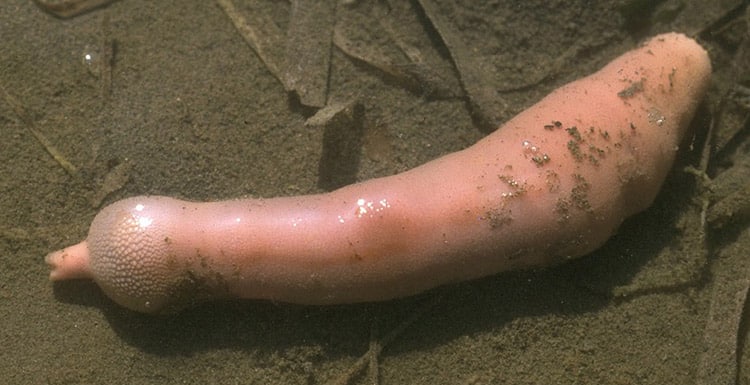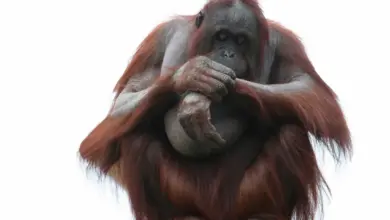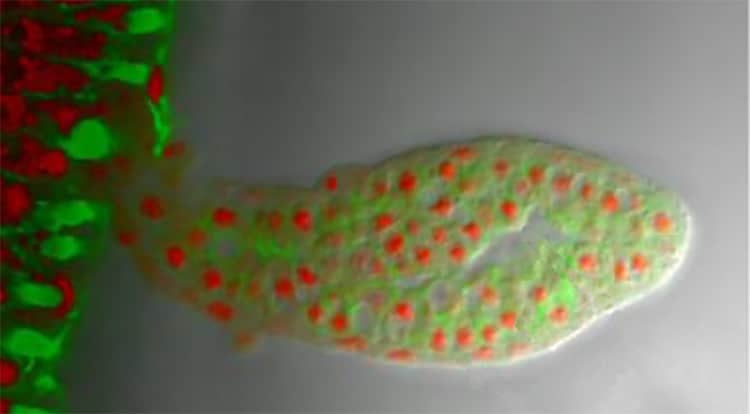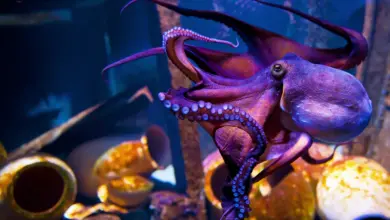The Crustacea are highly diverse and successful group of animals. They include Crabs, Prawns, Shrimps and Lobsters (but also Woodlice and Barnacles) are but a few of the wonderfully diverse members of the group of organisms known as the Crustacea.
The Crustacea are only the third largest of the great Arthropod subphylla.
They contain a lower number of species than either the insects or the arachnids. However in terms of diversity of form, they exceed both these groups together.
This great flexibility of structure, along with the general successfulness of the Arthropod plan (exoskeleton and jointed limbs), has enabled them to be extremely successful as a group of animals.
However it has also made it almost impossible to describe a typical Crustacean.

All Crustacea can be distinguished from the other groups of Arthropods by the possession of two pairs of antennae, and by the presence of biramous limbs.
Biramous limbs have a second section or branch, so they look in fact like two limbs stuck together (see diagram). The limbs of people, spiders and insects are all uniramous.
The Crustacea are an ancient group of organisms, with a fossil record stretching back to the early Cambrian 600 million years ago.
There is a Russian fossil of a 12 legged Sea Spider called Karagassiema that is reported to have come from rocks 650 million years old.
Crustaceans are almost entirely aquatic, with only a few hundreds of the 40,000 known species living terrestrially. Most species have free swimming larvae that become part of the plankton for a time.
The subphylum, or class in some classification schemes, is divided into 9 classes, or subclasses and about 43 orders.
Crustacean Facts
Did you know…
- That some Lobsters migrate from one place to another by walking in single file across the ocean’s floor.
- That some Marsupial Crab in Australia live in the middle of the desert up to 1,600 km (1,000 miles) from the sea.
- That in the forests of Jamaica there lives a crab called the Bromeliad Crab. It is the only crab known to look after its young after they have hatched, it catches food for them and chases away predators.
- That scientists believe that some specimens of the American Lobster (Homarus americanus) may live to be 100 years old.
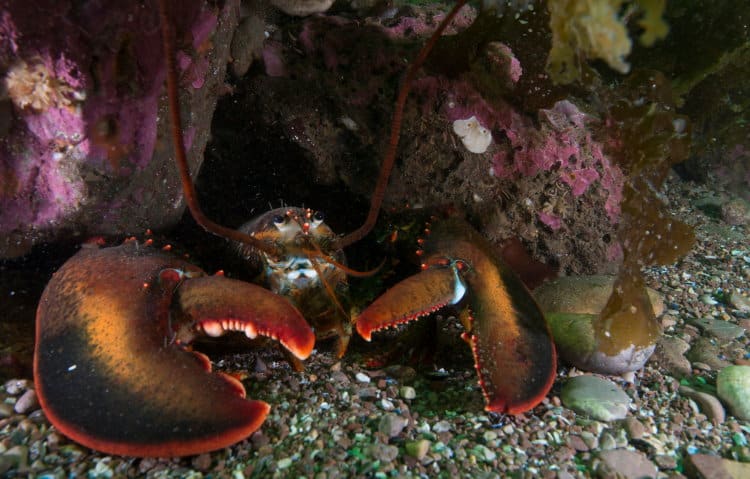
- That Lobsters communicate with each other by urinating into the water.
- That woodlice (whatever you call them) are crustaceans and not insects – despite the fact that they live on the land in nearly everybody’s garden.
- That the Ostracod Mussel Shrimp Pontocypris monstrosa produces sperm that are 6 times as long as its body!
- That Prawns and Shrimps make a lot of noise in the sea and can communicate with each other by clicking their pincers.
Crustaceans in the genus Gigantocypris are renowned for having the best night vision in the world.
If you measure the sensitivity of eyes using f-stop values (the way photographers measure camera lenses, where the lower the value the smaller the amount of light the eyes can detect) you will find that these Ostracods have eyes that register f-0.25, whereas human eyes register f-2.55.
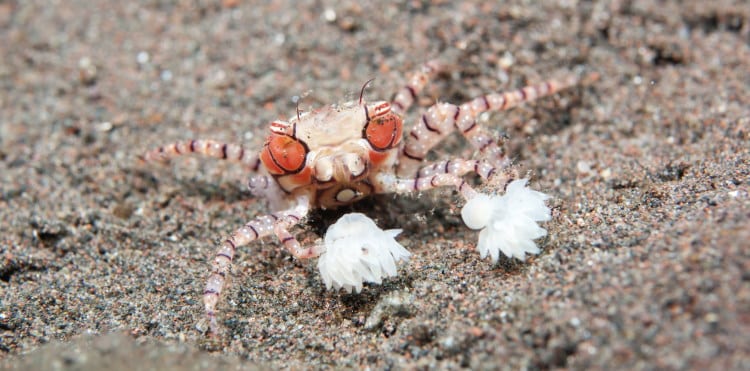
The Boxer Crab (Lybia tessellata) has evolved special claws to help it carry two sea anemones around with it!
When danger threatens it waves the sea anemones at the intruder, so that the stings of the anemone will drive it away. There are costs to everything in nature however… and the crab has had to learn to use its first pair of walking legs to eat with. It would sting itself in the face or lose its protection, if it ate with its claws like other crabs. Crabs are messy eaters so the anemone is happy, as he gets all the crab’s scraps.
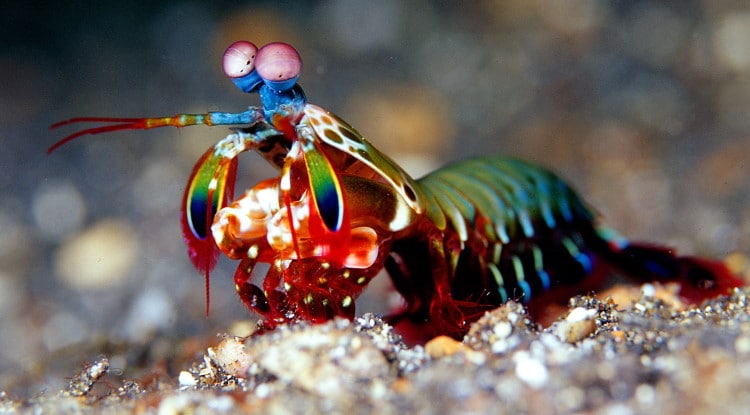
A Mantis Shrimp is the hardest hitting animal known to science, at least for its weight.
Mantis Shrimps are members of the family Stomatopoda. They are shrimps that prey on other Crustaceans by spearing or smashing them. A large species such as Hemisquilla ensigera, which is 25 cm long found in the waters off Californian, can deliver a punch with the impact velocity of a .22 rifle bullet and is capable of breaking double layered safety glass.
A Mantis Shrimp once made the headline news when it smashed one of the glass walls of the aquarium it was living in. Some Mantis Shrimps can strike at a speed that is ten times faster than a terrestrial Preying Mantis
That some Mantis Shrimps (family Stomatopoda) are believed to have the best colour vision of any animal known to science. They have ten different visual pigments in their eyes, as compared with the three that we as humans have. This would allow them to distinguish far finer grades of colour than us.
Crustaceans And Humanity
Many Crustaceans are directly important to our human lives, mostly as food but in a few cases as pests.
Crabs, Crayfish, Lobsters, Prawns and Shrimps are all part of the average human diet. Other species are important indirectly because they are food for other animals, such as Fish, Squid and Whales.
However, as a group the whole class is of great importance because of the role they play in maintaining the balance of productivity of the world’s lakes, oceans and seas.
Crustaceans are also interesting and valuable because of their beauty, their evolutionary diversity and the great enjoyment that can be gained by striving to understand the many wonders of their biology and ecology.
Crustaceans occur all over the world: from the slopes of mountains, where they have been recorded at 4,053 m (13,300 ft) in the Andes, to the bottom of the oceans where they have been seen at depths of 10,913 m (35,802 ft) in the Marianas Trench.
Sometimes they occur in such huge numbers that counting them is impossible. Krill, Euphausia superba, are small 6.5 cm (2.6 in) long, shrimp-like animals – that are probably the most numerous animals in the world. They live in the oceans near the poles, where they are eaten by whales, seals, penguins and many fish.

Despite these numerous predators, this small animal still exists in swarms so large they can tracked by satellite. Scientists estimate that a huge swarm spotted near Antarctica in 1981 contained at least 10 million tonnes of Krill. The word Krill comes from the Norwegian word for ‘Whale Food’.
The largest Crustacean in the world depends how you look at size.
The heaviest is the American, or North Atlantic Lobster Homarus americanus, the heaviest know specimen of which weighed 20.14 kg or 44 lb 6 oz.
However the largest in terms of leg-span is the Japanese Spider Crab Machocheira kaempferi, which has an average leg span of about 2.6 m or 8 ft 6 ins. The largest specimen caught had a leg span of 3.69 m (12 ft 1 in) and weighed 18.6 kg (41 lb).
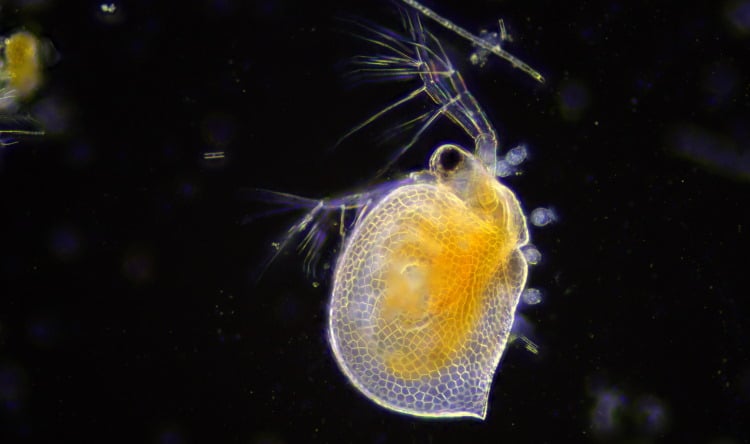
The smallest Crustaceans in the world are the Water Fleas of the genus Alonella, which can be adult at a mere 0.25 mm or about 100 of an inch in length.
While many crustaceans occur in large numbers, others are much rarer.
The IUCN has over 479 species on its list. One of these, the Socorro Isopod (Thermosphaeroma thermophilum) is now considered extinct in the wild. Of the rest 57 are listed as Critically Endangered and 77 as Endangered.
Taxonomy of the Crustacea Body in three parts, thorax in eight segments.
Subphylum Crustacea
- Class Branchiopoda – 1363 spp.
- Order Anostraca – 284 spp.
- Order Diplostraca – 1,069 spp.
- Order Notostraca – 10 spp.
- Class Branchiura
- Order Arguloida (Sea Lice) 32 spp. (sometimes included in Maxillipoda)
- Class Cephalocorida 10 spp..
- Order Brachypoda 10 spp.
- Class Hexanauplia – 14,776 spp.
- Order Calanoida – 2,759 spp.
- Order Canuelloida – 89 spp.
- Order Cyclopoida – 4,240 spp.
- Order Gelyelloida – 2 spp.
- Order Harpacticoida – 5,137 spp.
- Order Misophrioida – 37 spp.
- Order Monstrilloida – 169 spp.
- Order Mormonilloida – 4 spp.
- Order Platycopioida – 11 spp.
- Order Siphonostomatoida – 2,274 spp.
- Order Un-named – Various families not yet placed in any order. – 54 spp.
- Class Malacostrata – 35,856 spp.
- Order Amphionidacea – 1 spp.
- Order Amphipoda – 10,144 spp.
- Order Anaspidacea – 2 spp.
- Order Bathynellacea – 16 spp.
- Order Bochusacea – 6 spp.
- Order Cumacea – 1,734 spp.
- Order Decapoda – 10,709 spp.
- Order Euphausiacea – 86 spp.
- Order Isopoda – 10,377 spp.
- Order Leptostraca – 60 spp.
- Order Lophogastrida – 40 spp.
- Order Mysida – 1,071 spp.
- Order Stomatopoda – 159 spp.
- Order Tanaidacea – 1,413 spp.
- Order Thermosbaenacea – 38 spp.
- Class Maxillipoda 477 named spp.; plus another 26,000 uncertain
- Order Akentrogonida – 18 spp.
- Order Apygophora – 2 spp.
- Order Cephalobaenida – 2 spp.
- Order Dendrogastrida – 11 spp.
- Order Kentrogonida – 50 spp.
- Order Laurida – 8 spp.
- Order Pedunculata – 187 spp.
- Order Porocephalida – 4 spp.
- Order Pygophora – 10 spp.
- Order Scalpelliformes – 1 spp.
- Order Sessilia – 184 spp.
- Class Mystacocarida
- Order Mystacocaridida (Beach Mites) 13 spp.
- Class Ostracoda – 6,308 spp. plus another 6,700 uncertain
- Order Halocyprida – 438 spp.
- Order Myodocopida – 947 spp.
- Order Paleocopida – 209 Extinct spp.
- Order Platycopina – 149 spp.
- Order Podocopida – 4694 spp.
- Order un-named – Various families not yet placed in an order – 80 spp.
- Class Remipedia – 29 spp.
- Order Nectiopoda – 29 spp
Final Thoughts
Well, I hope you have enjoyed this introduction and few facts about the incredible world of crustaceans!
Perhaps now you’d be interested to learn about trilobites.

